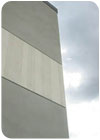
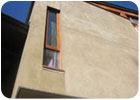
As with most things in life, there are advantages and disadvantages to each material. The first important step is not to confuse the two finishes with each other. Stucco is defined by Webster's dictionary as "an exterior plaster made of cement, lime and sand." While stucco is a natural cement product, acrylic finish is a synthetic man-made coating. Stucco cures to a hardened state while acrylics dry to their final hardened state. This is a critical difference when considering environmental conditions during application.
Regions of Canada and the United States seem to have a preference to one or the other finish coat material for Portland cement plaster bases. For example, traditional stucco finishes are much more popular in Southern California, while acrylic finish coat is more popular in Seattle. Vancouver, B.C., seems to have a fair mix between acrylic and stucco.
Designers must choose which finish material is most appropriate for the building and best meets the desires of their client. A checklist of the desired aspects is one good way to help decide which material should be used.
Texture:
Cement finish has practically an unlimited variety of textures from smooth trowel, mission and Old English to a combed. While acrylics have some range of texture, most acrylics are applied in a sand finish texture and the wide-range of texture choices is not their strong suit.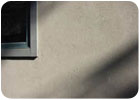
Color:
Acrylic finishes can come in just about any color imaginable and can be matched to almost any shade desired. The consistency of color is very good with acrylics, even in darker shades. Stucco, being cement based, can only hold so much pigment and dark tones are not recommended. Stucco works best in light pastel shades and some slight variation in color shade should be expected. This is particularly true with stucco sand-finish texture. Colored cement stucco can be "fog" coated, which is a good method to improve the color consistency.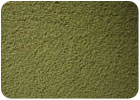
Application:
Acrylics dry from the outside in and can be sensitive to environmental conditions. Acrylic finish should not be applied in temperatures below 40 degrees F (4 degrees C). Sometimes, air circulation is more important for drying than temperature, especially in humid conditions. Cement stucco finish "cures," as opposed to drying and can be applied in temperatures as low as 35 degrees F (2 degrees C).The Portland cement plaster basecoat must be cured a minimum of seven days before applying acrylic or stucco but a longer cure time is beneficial. It gives the building additional time to "find itself" or settle before the finish coat is applied. The Northwest Wall & Ceiling Bureau recommends, if possible, waiting 14 to 21days.
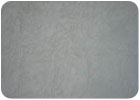
Water Repellency:
Traditional cement stucco, like all cement products, will absorb surface moisture and darken when wet. Acrylics, similar to a nylon stocking, will repel surface moisture but moisture will pass through as a vapor. Acrylics should never be mistakenly used or sold as a method to "seal" the building from water intrusion. Properly applied Portland cement plaster basecoat will seal moisture out and be vapor permeable. It is advisable that finish coat materials, including paint, be a "breathable" membrane. Acrylic finish should never be used on flat surfaces or other areas of possible standing water, as they can soften with prolonged exposure to moisture. An advantage of acrylic finish is that they retain their color when wet and are particularly desirable in wet climates, again, not to seal but to stay one constant shade of color even when wet.Many cement stucco manufacturers offer clear sealers that will provide the same water repellant benefit as acrylics. Most only last a year or two and may have to be reapplied every few years. This is a simple procedure and not very expensive.
Maintenance:
Both stucco and acrylic finish are relatively low maintenance and both can be painted when a change of color is desired. The life expectancy of a stucco finish coat has been proven to be several decades. Acrylics have been applied to cement basecoats in Seattle for more than 20 years and many of these original finish coats are holding up quite well.Corner Beads:
The type of finish chosen will have an impact on the corner bead or corner aid that should be used. In particular, one should be concerned about the type of nose on the corner bead. Acrylics tend to work best with a PVC or plastic nose type of corner aid. The acrylic bonds to the plastic and it eliminates the rusting that can occur with wire nose beads and an acrylic finish coat. With traditional cement finish stucco, the nose should be wire. Cement will stick to the PVC but not bond. It will eventually pop off the corners. Also consider the PVC is flexible and the cement finish is not.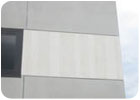
Closing Words:
Both finishes have strong points and limitations. No one product is the answer to all situations or projects. Designers and owners should look at a building with traditional stucco and one with an acrylic finish before making a final decision. Contractors, dealers and manufacturers should listen to the desires of the building owners and designers and try to find the product that is right for them. Contractors should learn to work with a variety of materials and not limit themselves to only what they feel is best for the customer. Only use recognized products by manufacturers with a proven track and service record. I recommend pre-manufactured (mill mixed) cement stucco finish coats over site mixed blends. The few pennies you might save are not worth the gamble of job-site blending. The NWCB publishes industry standards for proper application of both finish materials. Whether stucco or an acrylic finish is used, it is always important to follow manufacturers recommendations and guidelines.If you read this article, please circle number 322.

